
August 22, 2024
New Mole On Face Or Body: Reasons And When To Be Concerned
Brand-new Mole check here On Face Or Body: Causes And When To Be Worried You likewise should have your moles inspected if they bleed, exude, impulse, scale, or soften or uncomfortable. A "pigmented sore" is a basic term that includes regular moles, sunlight blemishes or age spots (lentigines). Cancer malignancies develop from melanin-containing cells, called melanocytes. Individuals with fair skin, red or blond hair or who invest a great deal of time in strong sunlight are at greater danger of creating melanoma. It is very important to avoid prolonged sunlight or various other UV radiation direct exposure to lower the risk of establishing dysplastic or malignant moles.What Creates Freckles?
Pictorial case study - Concern about changes to a mole - GP online
Pictorial case study - Concern about changes to a mole.

Posted: Fri, 02 Aug 2013 07:00:00 GMT [source]
- Usual moles typically establish because of sun direct exposure and procedure in between 5 to 6 mm.
- Moles are growths on the skin that are generally brownish or black.
- " Melanocytes are usually present throughout the body-- when a team of these cells collections, you obtain a visible development called a mole."
- A mole with irregular or jagged boundaries must be examined by a skin expert.
Ecological Elements You Really Did Not Know Can Affect Your Skin
Talk with your health care expert about your threat elements for cancer malignancy and whether you require a specialist skin examination frequently. The following ABCDEs are necessary things to think about when examining moles. If a mole shows any one of the signs listed here, have it examined by a skin specialist as soon as possible.What Does Cancer Malignancy Resemble?
Sometimes, you look at a mole and believe, "That does not look quite ideal." Do not overlook those suspicions. There's a chance what you see may suggest melanoma, an unsafe type of skin cancer cells. The only method to detect cancer malignancy is to remove cells and inspect it for cancer cells. The physician will eliminate all or part of the skin that looks abnormal. Typically, this treatment takes only a few mins and can be carried out in a doctor's office, clinic, or hospital. Your skin specialist will certainly know whether or not any type of moles require a biopsy to guarantee they are not melanomas. The more irregular functions moles have, the riskier they are. Regular surveillance of these moles is especially critical, to ensure that if a melanoma develops, it can be detected and treated as early as feasible. It is essential to note that even without a household background of melanoma, if you have atypical moles, you have a raised threat of developing melanoma. While pregnant, for example, a female's moles may end up being larger and darker or go through various other adjustments. Though this does not constantly indicate a problem, it is best to have any mole that's transforming assessed. Moles are collections of melanocytes, which are the cells that develop and offer your skin its pigment. All skin kinds-- despite exactly how reasonable or dark-- contain melanocytes as a typical part of the epidermis. Numerous skin tags begin as skin-colored bumps, yet they might progress to become extra pigmented. Any changing sore on your skin must be examined by a skin specialist, but this specific adjustment is taken into consideration benign. Dr. Poblete-Lopez suggests doing skin self-checks once a month. Make use of the time to search for new moles and check out existing moles for anything uncommon. Speak with your healthcare provider about any kind of concerning searchings for. Relying on what they see, they might carry out a skin biopsy. This is the only means to definitively discover whether a mole is cancerous. Moles are available in different dimensions, appearances, and shades. Irregularly formed moles with more colors have a better opportunity of being cancerous. It is very important to seek advice from a doctor if a mole's look adjustments, if it becomes unpleasant, or if you're uncertain whether it's benign. Skin changes as you get older and are subjected to sunlight, wellness conditions, injury, and other environmental adjustments. Blemishes are caused by a genetic tendency to create even more melanin, the pigment that provides skin its shade. When skin is subjected to the sunlight, blemishes will certainly come to be darker. We are committed to aiding you maintain healthy skin at Valley Skin Institute. Please contact us if you see any adjustments in your moles or have any kind of problems. Our team of specialists is right here to offer customized suggestions and treatment to guarantee your skin remains healthy. Atypical moles have the prospective to come to be cancerous. These SKs can take place anywhere on the body, yet they are particularly typical along the hairline and at sites of friction on the body. Seborrheic keratoses are harmless skin developments, and actually, they are so benign that there is no considerable research study that has actually been done to uncover their reason! Because so little is understood about seborrheic keratoses, dermatologists do not know exactly how to avoid them, however we do understand that they are not contagious or harmful.Can a mole be unusual however not cancerous?
Some irregular (in addition to typical) moles can change into melanoma, however the majority of irregular moles will never ever transform to cancer cells. As a matter of fact, cancer malignancy is most likely to establish as a new, unusual place on normal skin, unassociated to moles. Consequently, having moles gotten rid of will certainly not protect against cancer malignancy.

Social Links